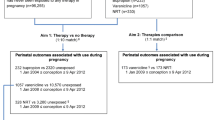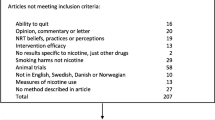Abstract
Objectives Although nicotine replacement therapies (NRT) may assist with smoking cessation, little is known about the safety of NRT use during pregnancy. Our purpose was two-fold: to determine characteristics of women prescribed or recommended NRT during pregnancy and to investigate whether NRT prescription/recommendation was associated with adverse pregnancy outcomes using data from the 2004 Pregnancy Risk Assessment Monitoring System. Methods Smoking and NRT referral was self-reported by 5,716 women. Information on pregnancy outcomes was obtained from birth certificates. Multivariate logistic regression was used to calculate odds ratios (ORs) and 95% confidence intervals (CIs). Results Smokers <35 years of age and of Hispanic, Non-Hispanic Black, and Asian/Pacific Islander race/ethnicity were less likely to be prescribed or recommended NRT during pregnancy. After adjustment for age, marital status, education, and race/ethnicity, women recommended NRT had twice the risk of low birthweight as compared to nonsmokers (OR = 1.95, 95% CI: 1.10, 3.46) while smokers had 1.31 times the risk of low birthweight (95% CI: 0.92, 1.87). Results for preterm birth were similar after adjustment for the same confounding variables (NRT: OR = 2.04, 95% CI: 1.14, 3.63 and smoking: OR = 1.09, 95% CI: 0.74, 1.61). Conclusions Risks of low birthweight and preterm birth were highest for women prescribed or recommended NRT. These findings may be related to frequency of maternal smoking. While heavier smokers may be more likely to be recommended NRT, they also may have the most difficulty with cessation. Greater efforts should be made to ensure that these women do successfully cease smoking.
Similar content being viewed by others
References
US Department of Health and Human Services. (2001). Women and Smoking: A Report of the Surgeon General. Rockville, MD: US Department of Health and Human Services, Public Health Service, Office of the Surgeon General; Washington D.C.
Centers for Disease Control, Prevention. (2004). Smoking during pregnancy-United States, 1990–2002. MMWR, 53, 911–915.
Oncken, C. (1996). Nicotine replacement therapy during pregnancy. American Journal of Health Behavior, 20, 300–304.
Oncken, C. A., Pbert, L., Ockene, J. K., Zapka, J., & Stoddard, A. (2000). Nicotine replacement prescription practices of obstetric and pediatric clinicians. Obstetrics Gynecology, 96, 261–265. doi:10.1016/S0029-7844(00)00905-4.
Centers for Disease Control and Prevention. (2006). Maternal and infant health: Smoking during pregnancy. Available from http://www.cdc.gov/reproductivehealth/TobaccoUsePregnancy/index.htm. Retrieved October 17, 2006.
US Department of Health and Human Services. (2006). Healthy people 2010. Available from http://www.healthypeople.gov. Retrieved October 17, 2006.
Walsh, R. A., Redman, S., & Adamson, L. (1996). The accuracy of self-report of smoking status in pregnant women. Addictive Behaviors, 21, 675–679. doi:10.1016/0306-4603(95)00097-6.
Kranzler, H. R., & Oncken, C. A. (2003). Pharmacotherapies to enhance smoking cessation during pregnancy. Drug and Alcohol Review, 22, 191–202. doi:10.1080/09595230100100633.
Benowitz, N. L., & Dempsey, D. A. (2001). Risks and benefits of nicotine to aid smoking cessation in pregnancy. Drug Safety, 24, 277–322. doi:10.2165/00002018-200124040-00005.
Prevention and early detection: Guide to quitting smoking. (2006). American Cancer Society http://www.cancer.org/docroot/PED/content/PED_10_13X_Guide_for_Quitting_Smoking.asp. Retrieved October 17, 2006.
Drake, J. A., Jordan, T., & Price, J. H. (2006). Obstetricians and gynecologists’ perceptions and use of nicotine replacement therapy. Journal of Community Health, 31, 60–175.
Pregnancy Risk Assessment Monitoring System 2000–2003 Surveillance Report. (2003). Atlanta, GA: US Department of Health and Human Services, CDC, National Center for Chronic Disease Prevention and Health Promotion, Division of Reproductive Health, 2003.
Raatikaninen, K., Heinonen, S., & Huurinainen, P. (2006). Smoking in early gestation or through pregnancy: A decision crucial to pregnancy outcome. Preventive Medicine, 1–5.
Henriken, T. B., Kesmodel, U.,Wisborg, K., Olsen, S. F., & Secher, N. J. (2001). Exposure to tobacco smoke in Utero and the risk of stillbirth and death in the first year of life. American Journal of Epidemiology, 154, 323–327.
Meyers, M. B., Jonas, B. S., & Tonascia, J. A. (1976). Perinatal events associated with maternal smoking during pregnancy. American Journal of Epidemiology, 103, 464–476.
Hotham, E. D., Gilbert, A. L., & Atkinson, E. R. (2005). Case studies of three pregnant smokers and their use of nicotine replacement therapy. Midwifery, 21, 224–232. doi:10.1016/j.midw.2004.12.008.
Hotham, E. D., Gilbert, A. L., & Atkinson, E. R. (2006). A randomized-controlled pilot study using nicotine patches with pregnant women. Addictive Behaviors, 31, 641–648. doi:10.1016/j.addbeh.2005.05.042.
Maldonado, G., & Greenland, S. (1993). Simulation study of confounder selection strategies. American Journal of Epidemiology, 138, 923–936.
Ogburn, P. L., Hurt, R. D., Croghan, I. T., Schroeder, D. R., Ramin, K. D., Offord, K. P., & Moyer, T. P. (1999). Nicotine patch use in pregnant smokers: Nicotine and cotinine levels and fetal effects. American Journal of Obstetrics and Gynecology, 181, 736–743. doi:10.1016/S0002-9378(99)70521-1.
Benowitz, N. L. (1991). Nicotine replacement therapy during pregnancy. JAMA, 266, 3174–3177. doi:10.1001/jama.266.22.3174.
Coleman, T., Britton, J., & Thornton, J. (2004). Nicotine replacement therapy in pregnancy: Is probably safer than smoking. BMJ, 328, 965–966. doi:10.1136/bmj.328.7446.965.
Oncken, C. A., Hatsukami, D. K., Lupo, V. R., Lando, H. A., Gibeau, L. M., & Hansen, R. J. (1996). Effects of short-term use of nicotine gum in pregnant smokers. Clinical Pharmacology and Therapeutics, 59, 654–661. doi:10.1016/S0009-9236(96)90005-3.
Benowitz, N. L., Jacob, P., & Dempsey, D. (2002). Accelerated metabolism of nicotine and cotinine in pregnant smokers. The Journal of Pharmacology and Experimental Therapeutics, 301, 594–598. doi:10.1124/jpet.301.2.594.
Oncken, C. A., Hardardottir, H., Hatsukami, D. K., Lupo, V. R., Rodis, J. F., & Smeltzer, J. S. (1997). Effects of transdermal nicotine or smoking on nicotine concentrations and maternal-fetal hemodynamics. Obstetrics and Gynecology, 90, 569–574. doi:10.1016/S0029-7844(97)00309-8.
Hansen, R., Luck, W., Nau, H., & Steldinger, R. (1985). Extent of nicotine and cotinine transfer to the human fetus, placenta, and amniotic fluid of smoking mothers. Developmental Pharmacology and Therapeutics, 8, 384–395.
Kapur, B., Hackman, R., Selby, P., Klein, J., & Koren, G. (2001). Randomized, double blind, placebo-controlled trial of nicotine replacement therapy in pregnancy. Current Therapeutic Research, 62, 274–278. doi:10.1016/S0011-393X(01)80011-4.
Lindblad, A., & Marsal, K. (1987). Influence of nicotine chewing gum on fetal blood flow. Journal of Perinatal Medicine, 15, 304–310.
Acknowledgments
The authors thank Denise D’Angelo, the CDC PRAMS research proposal coordinator, the PRAMS Working Group: Alabama – Albert Woolbright, PhD; Alaska – Kathy Perham-Hester, MS, MPH; Arkansas – Mary McGehee, PhD; Colorado – Alyson Shupe, PhD; Delaware – Charlon Kroelinger, PhD; Florida – Jamie Fairclough, MPH; Georgia – Carol Hoban, MS, MPH; Hawaii – Sharon Sirling; Illinois – Theresa Sandidge, MA; Louisiana – Joan Wightkin; Maine – Kim Haggan; Maryland – Diana Cheng, MD; Massachusetts – Hafsatou Diop, MD, MPH; Michigan – Violanda Grigorescu, MD, MSPH; Minnesota – Jan Jernell; Mississippi – Vernesia Wilson, MPH; Missouri – Venkata Garikapaty, MSc, MS, PhD, MPH; Montana – JoAnn Dotson; Nebraska – Jennifer Severe-Oforah; New Jersey – Lakota Kruse, MD; New Mexico – Eirian Coronado; New York State – Anne Radigan-Garcia; New York City – Candace Mulready-Ward, MPH; North Carolina – Paul Buescher, PhD; North Dakota – Sandra Anseth; Ohio – Lily Tatham; Oklahoma – Dick Lorenz; Oregon – Kenneth Rosenberg, MD; Pennsylvania – Kenneth Huling; Rhode Island – Sam Viner-Brown, PhD; South Carolina – Jim Ferguson, DrPH; South Dakota – Christine Rinki, MPH; Texas – Eric Miller, PhD; Tennessee – David Law, PhD; Utah – Laurie Baksh; Vermont – Peggy Brozicevic; Virginia – Michelle White; Washington – Linda Lohdefinck; West Virginia – Melissa Baker, MA; Wisconsin – Katherine Kvale, PhD; Wyoming – Angi Crotsenberg; as well as the CDC PRAMS Team, Applied Sciences Branch, Division of Reproductive Health.
Author information
Authors and Affiliations
Corresponding author
Rights and permissions
About this article
Cite this article
Gaither, K.H., Huber, L.R.B., Thompson, M.E. et al. Does the Use of Nicotine Replacement Therapy During Pregnancy Affect Pregnancy Outcomes?. Matern Child Health J 13, 497–504 (2009). https://doi.org/10.1007/s10995-008-0361-1
Received:
Accepted:
Published:
Issue Date:
DOI: https://doi.org/10.1007/s10995-008-0361-1




